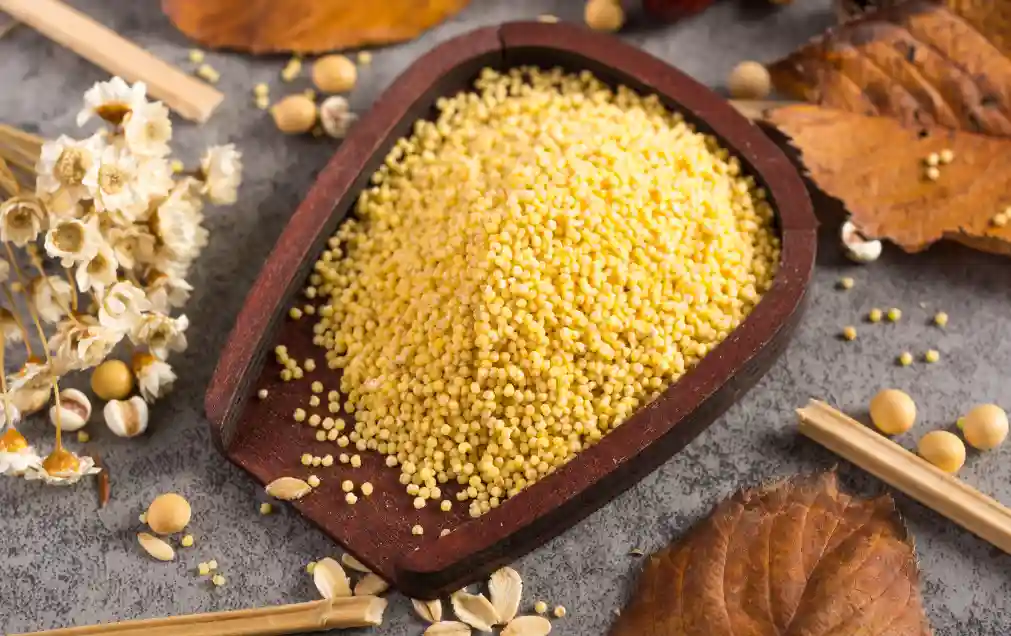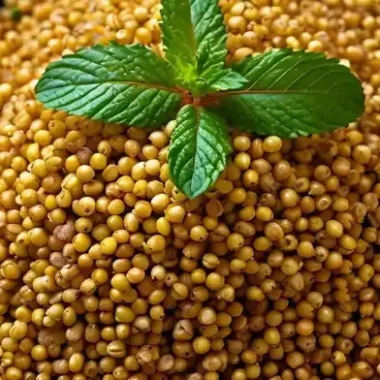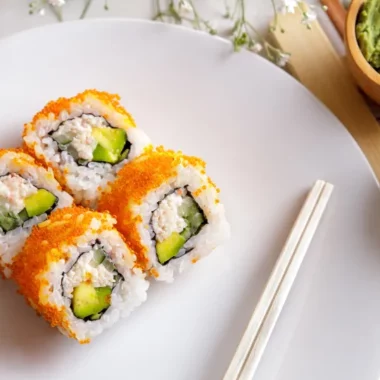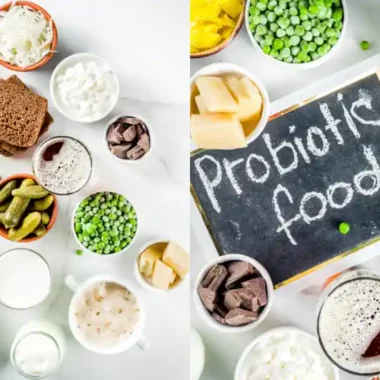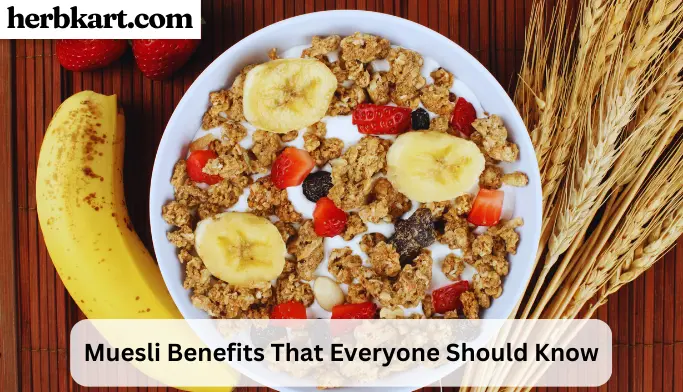Hey there, fellow food lovers! Have you ever heard of millets? These fantastic little grains have fed people for centuries, especially in Africa and Asia. Think of them as the hidden gems of the food world! Millets are packed with good stuff like protein, fibre, and essential minerals – you know, the things your body loves. Plus, they’re naturally gluten-free, which is fantastic if you avoid gluten.
But millets are more than just healthy. They’re super versatile, too! You can use them to make creamy porridges, hearty breakfast bowls, fresh salads, stir-fries bursting with flavour, and even traditional bread like roti and injera. And guess what? You can even find millet flour to make delicious baked goods like bread and crepes!
And here’s the cool part: millets have a unique cultural significance. They represent community, resilience, and the beauty of simple things – values we could all use a little more of these days, right? Did you know that millet even played a role in the millet system of the Ottoman Empire? It’s true!
With their subtle nutty flavours, millets are like a culinary adventure waiting to happen. So why not give them a try? You might rediscover the joy of wholesome, natural eating and connect with the rich history of these incredible grains. We’ll explore popular millets like pearl, foxtail, and finger millet and learn how to cook them in delicious and accessible ways. Let’s dive in!
Table of Contents
What are Millets?
Have you ever heard of millets? These fantastic little grains have fed people for centuries, especially in Africa and Asia. Think of them as the hidden gems of the food world! They’re packed with good stuff like protein, fibre, and essential minerals – you know, the things your body loves. Plus, they’re naturally gluten-free, which is fantastic if you avoid gluten.
But millets are more than just healthy. They’re super versatile, too! Their potential is endless, inspiring you to create a variety of dishes, from creamy porridges to hearty breakfast bowls, fresh salads, and stir-fries bursting with flavor. They even make traditional bread like roti and injera. Let your creativity run wild with these fantastic grains!
And here’s the cool part: millets have a particular cultural significance. They represent community, resilience, and the beauty of simple things – values that are deeply rooted in our heritage and that we could all use a little more of these days, right?
With their subtle nutty flavors, millets are like a culinary adventure waiting to happen. So why not step out of your comfort zone and give them a try? You might just rediscover the joy of wholesome, natural eating and connect with the rich history of these incredible grains. Be adventurous and open-minded in your culinary journey!
Why We Love Millets (and You Should Too!)
Okay, let’s get honest about why millets are so fantastic:
- Nutrient Powerhouses: Millets are bursting with essential vitamins and minerals. We’re talking iron for healthy blood, magnesium for strong bones, and potassium for a happy heart. They’re also loaded with fibre to keep your digestion running smoothly and protein to help you power through your day.
- Gluten-Free Goodness: Millets are your new best friend if you’re living that gluten-free life. They’re naturally gluten-free so that you can enjoy them without any worries.
- Blood Sugar Heroes: Millets have a low glycemic index (GI), so they won’t cause your blood sugar to spike. This is excellent news for people with diabetes or anyone who wants to keep their energy levels stable.
- Digestive Support: The high fibre content in millets keeps your digestive system happy and helps prevent constipation.
- Heart Health Champions: Millets are packed with magnesium and potassium, essential for maintaining healthy blood pressure and reducing the risk of heart disease.
- Antioxidant Power: Millets are full of antioxidants, those fantastic little compounds that protect your cells from damage and help you stay healthy.
- Sustainable Superstars: Millets are drought-resistant and require less water to grow than other grains, making them a friend to the environment.
Millets: More Than Just a Grain
Millets offer a whole range of benefits beyond just essential nutrition:
- Therapeutic Wonders: Since they’re gluten-free, millets are an excellent choice for people with celiac disease or gluten sensitivity. They may also help manage irritable bowel syndrome (IBS) symptoms and even reduce the severity of menopausal symptoms.
- Preventive Power: Eating millet regularly may help prevent chronic diseases like heart disease, diabetes, and certain cancers. They can also support healthy ageing, strong bones, and a robust immune system.
Millets and the World
Millet has played an important role in cultures around the globe for centuries. It is a symbol of community, resilience, and sustainable living. In some cultures, millet is even used in traditional ceremonies and celebrations.
Millets in Your Kitchen
Ready to start cooking with millets? Here are a few ideas to get you started:
- Breakfast: Cook a creamy millet porridge or add some cooked millet to your morning yoghurt or smoothie.
- Lunch and Dinner: Use millet as a base for hearty salads, stir-fries, or a side dish instead of rice or quinoa. You can even try millet and brown rice ramen for a fun twist!
- Baking: Experiment with millet flour to make pancakes, muffins, and other delicious treats.
Millets Nutritional Value (Per 100 Grams)
The following table contains the nutrients value based on Macronutrients, Fiber, Vitamins and Energy.
| Nutrients | Minimum Nutritional Value (100 Grams) | Maximum Nutritional Value (100 Grams) |
| Energy | 320 kcal | 350 kcal |
| Protein | 8g | 12g |
| Fat | 1g | 4g |
| Carbohydrates | 60g | 70g |
| Fiber | 2g | 12g |
| Iron | 5mg | 18mg |
| Calcium | 10mg | 100mg |
| Potassium | 200mg | 550mg |
| Phosphorus | 100 | 300mg |
| Magnesium | 40mg | 100mg |
| Thiamin (B1) | 0.4mg | 1.2mg |
| Riboflavin (B2) | 0.1mg | 0.3mg |
| Niacin (B3) | 1mg | 3mg |
| Folate (B9) | 10mcg | 30mcg |
List of Types of Millets
- Foxtail Millet (Kakum / Kangni)
- Proso Millet (Chena / Barri)
- Sorghum Millet (Jowar)
- Finger Millet (Ragi)
- Pearl Millet (Bajra)
- Browntop Millet (Korle)
- Barnyard Millet (Sanwa)
- Little Millet (Moraiyo)
- Buckwheat Millet (Kuttu)
- Kodo Millet
Types of Millets
1. Foxtail Millet (Kakum / Kangni)

- Origin: Foxtail millet originated in China, India, and Southeast Asia.
- Nutrient Contents: Foxtail Millet (Kakum / Kangni) millet is a nutrient-rich grain with a mild flavour. Its tiny, flat seeds boast high protein (12.3g), fibre (6.7g), and iron (10.8mg) content, making it an excellent choice for health-conscious individuals. Foxtail millet is versatile in culinary applications, and it is used in traditional dishes like Pongal, dosas, and idlis, as well as bread. Its gluten-free status and high fibre content support digestive health and cholesterol reduction.
| Nutrients in Foxtail Millet (Kakum / Kangni) | Nutrients value as per 100 grams |
| Energy | 331 kcal |
| Protein | 12.3g |
| Fat | 3.5g |
| Carbohydrates | 63.2g |
| Fiber | 6.7g |
| Iron | 10.8mg |
| Calcium | 31mg |
| Potassium | 484mg |
- Health Benefits of Foxtail Millet (Kakum / Kangni): Foxtail millet is a nutrient-rich grain with several health benefits. It is gluten-free, making it suitable for individuals with celiac disease or gluten intolerance. With a high fibre content of 6.7g per 100g, foxtail millet supports digestive health and promotes regular bowel movements. Additionally, it is rich in iron (10.8mg/100g) and calcium (31mg/100g), essential minerals for maintaining healthy red blood cells and strong bones. Foxtail millet’s antioxidant properties also help prevent chronic diseases.
2. Proso Millet (Chena / Barri)
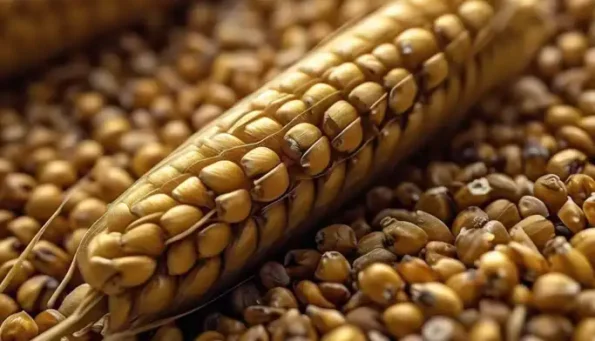
Origin: Proso millet hails from the Middle East, Europe, and Asia.
Nutrient Contents: Proso Millet (Chena / Barri) is distinguished by its tiny, rounded seeds and sweet flavour. This millet offers impressive nutritional benefits, including high protein (10.9g), fibre (5.2g), and potassium (429mg) content. Proso millet is ideal for bread, porridge, and salads, and its low glycemic index supports heart health and weight management.
| Proso Millet (Chena / Barri) | Nutrients value as per 100 grams |
| Energy | 329 kcal |
| Protein | 10.9g |
| Fat | 2.2g |
| Carbohydrates | 64.1g |
| Fiber | 5.2g |
| Iron | 8.4mg |
| Calcium | 20mg |
| Potassium | 429mg |
- Health Benefits of Proso Millet (Chena / Barri): Proso millet is an excellent source of protein (10.9g/100g), making it ideal for muscle growth and repair. Its high fibre content (5.2g/100g) and potassium (429mg/100g) support heart health by reducing cholesterol levels and blood pressure. Proso millet is also low in calories (329 kcal/100g), making it an excellent choice for weight management. Furthermore, it is a good vitamin B6 and folate source, essential for energy metabolism and red blood cell production.
3. Sorghum Millet (Jowar)
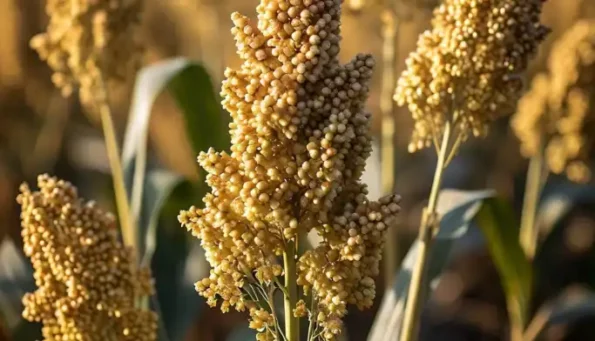
Origin: Sorghum millet, native to Africa, Asia, and the United States.
Nutritional Contents: Sorghum Millet (Jowar) features large, rounded seeds with a sweet flavour. Its nutritional profile highlights high carbohydrates (69.1g), fibre (2.6g), and iron (4.4mg) content. Sorghum millet is commonly used in bread, roti, and porridge, and its gluten-free status supports digestive health and cholesterol reduction.
| Sorghum Millet (Jowar) | Nutrients value as per 100 grams |
| Energy | 329 kcal |
| Protein | 8.4g |
| Fat | 1.9g |
| Carbohydrates | 69.1g |
| Fiber | 2.6g |
| Iron | 4.4mg |
| Calcium | 25mg |
| Potassium | 363mg |
- Health Benefits of Sorghum Millet (Jowar): Sorghum millet is gluten-free and rich in antioxidants, making it an excellent choice for individuals with gluten intolerance or celiac disease. Its high fibre content (2.6g/100g) supports digestive health, while its iron (4.4mg/100g) and calcium (25mg/100g) content promote healthy red blood cells and strong bones. Sorghum millet’s antioxidant properties also help prevent chronic diseases.
4. Finger Millet (Ragi)
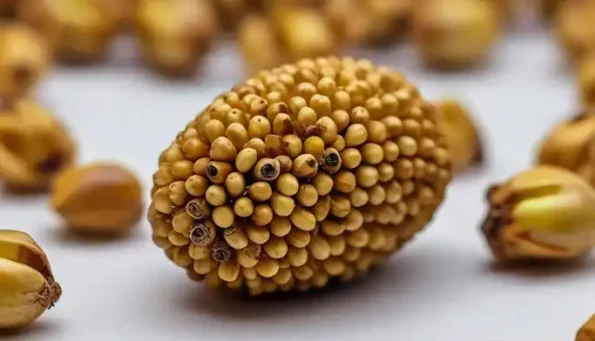
- Origin: Finger millet, originating from Africa and Asia. Boasts tiny, finger-shaped seeds with a nutty flavor.
- Finger Millet (Ragi) is a finger-shaped seed with a nutty flavour. Its exceptional nutritional profile includes high calcium (344mg), iron (13.6mg), and fibre (3.6g) content. Finger millet is traditionally used in porridge, roti, and bread, supporting bone health, reducing anaemia, and aiding weight management.
| Proso Millet (Chena / Barri) | Nutrients value as per 100 grams |
| Energy | 328 kcal |
| Protein | 7.7g |
| Fat | 1.3g |
| Carbohydrates | 70.6g |
| Fiber | 3.6g |
| Iron | 13.6mg |
| Calcium | 344mg |
| Potassium | 443mg |
- Health Benefits of Sorghum Millet (Jowar): Finger millet is an excellent source of calcium (344mg/100g), essential for maintaining strong bones and teeth. Its high fibre content (3.6g/100g) supports digestive health, while its iron (13.6mg/100g) and potassium (443mg/100g) content promotes healthy red blood cells and heart health. Finger millet’s antioxidant properties also help prevent chronic diseases.
5. Pearl Millet (Bajra)
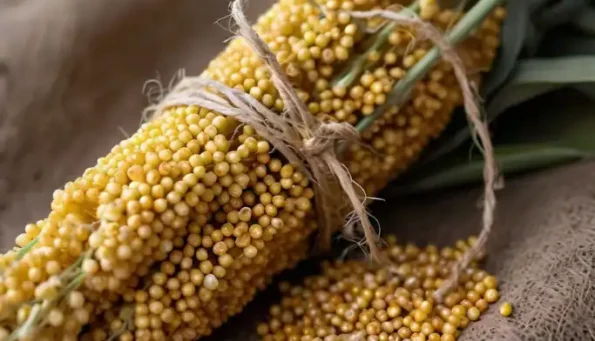
- Origin: Pearl millet is native to Africa and Asia.
- Nutrient Contents: Pearl Millet (Bajra) features tiny, rounded seeds with a mild flavour. Its nutritional benefits encompass high protein (10.6g), fibre (1.2g), and potassium (552mg) content. Pearl millet is commonly used in roti, bread, and porridge, supporting heart health, reducing cholesterol, and aiding weight management.
| Proso Millet (Chena / Barri) | Nutrients value as per 100 grams |
| Energy | 363 kcal |
| Protein | 10.6g |
| Fat | 4.2g |
| Carbohydrates | 66.6g |
| Fiber | 1.2g |
| Iron | 8.0mg |
| Calcium | 42mg |
| Potassium | 552mg |
- Health Benefits of Pearl Millet (Bajra): Pearl millet is rich in protein (10.6g/100g), fibre (1.2g/100g), and potassium (552mg/100g), making it an excellent choice for heart health. Its low-calorie content (363 kcal/100g) also aids weight management. Pearl millet is a good vitamin B6 and folate source, essential for energy metabolism and red blood cell production.
6. Browntop Millet (Korle)
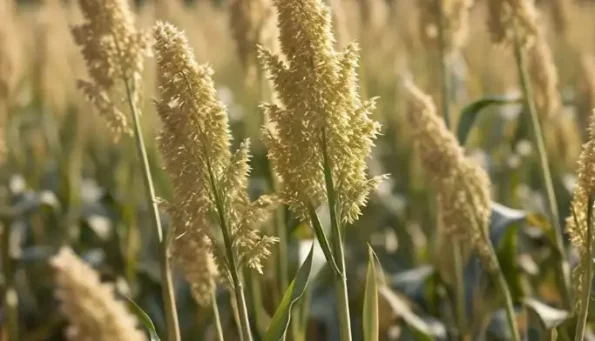
- Origin: Browntop millet hails from India and Southeast Asia.
- Nutrient Contents: Browntop Millet (Korle) is distinguishable by its tiny, flat seeds and mild flavour. Its impressive nutritional profile highlights high fibre (12.5g), iron (13.9mg), and calcium (17mg) content. Browntop millet is traditionally used in porridge, dosas, and idlis, supporting digestive health, reducing cholesterol, and aiding weight management.
| Proso Millet (Chena / Barri) | Nutrients value as per 100 grams |
| Energy | 315 kcal |
| Protein | 8.9g |
| Fat | 2.1g |
| Carbohydrates | 62.9g |
| Fiber | 12.5g |
| Iron | 13.9mg |
| Calcium | 17mg |
| Potassium | 294mg |
- Health Benefits of Browntop Millet (Korle): Browntop millet is high in fibre (12.5g/100g), antioxidants, and phytochemicals, supporting digestive health and preventing chronic diseases. Its iron (13.9mg/100g) and calcium (17mg/100g) content promote healthy red blood cells and strong bones. Browntop millet’s low-calorie content (315 kcal/100g) also aids weight management.
7. Barnyard Millet (Sanwa)

- Origin: Barnyard millet originating from India and Southeast Asia
- Nutrient Contents: Barnyard Millet (Sanwa) features tiny, rounded seeds with a mild flavour. Its exceptional nutritional profile includes high protein (11.2g), fibre (10.1g), and iron (18.6mg) content. Barnyard millet is commonly used in porridge, roti, and bread, supporting heart health, reducing cholesterol, and aiding weight management.
| Proso Millet (Chena / Barri) | Nutrients value as per 100 grams |
| Energy | 278 kcal |
| Protein | 11.2g |
| Fat | 2.2g |
| Carbohydrates | 55.6g |
| Fiber | 10.1g |
| Iron | 18.6mg |
| Calcium | 22mg |
| Potassium | 294mg |
- Health Benefits of Browntop Millet (Korle): Barnyard millet is rich in protein (11.2g/100g), fibre (10.1g/100g), and potassium (294mg/100g), supporting heart health and digestive health. Its iron (18.6mg/100g) and calcium (22mg/100g) content promote healthy red blood cells and strong bones. Barnyard millet’s antioxidant properties also help prevent chronic diseases.
8. Little Millet (Moraiyo)

- Origin: Little millet is a native to India and Southeast Asia.
- Nutrient Contents: Little Millet (Moraiyo) is a rounded seed with a sweet flavour. Its nutritional benefits encompass high protein (9.5g), fibre (7.6g), and iron (9.3mg) content. Little millet is traditionally used in porridge, dosas, and idlis, supporting digestive health, reducing cholesterol, and aiding weight management.
| Proso Millet (Chena / Barri) | Nutrients value as per 100 grams |
| Energy | 285 kcal |
| Protein | 9.5g |
| Fat | 4.7g |
| Carbohydrates | 67g |
| Fiber | 7.6g |
| Iron | 9.3mg |
| Calcium | 17mg |
| Potassium | 320mg |
- Health Benefits of Little Millet (Moraiyo): Little millet is high in fibre (7.6g/100g) and antioxidants, supporting digestive health and preventing chronic diseases. Its iron (9.3mg/100g) and potassium (320mg/100g) content promote healthy red blood cells and heart health. Little millet’s low-calorie content (285 kcal/100g) also aids weight management.
9. Buckwheat Millet (Kuttu)
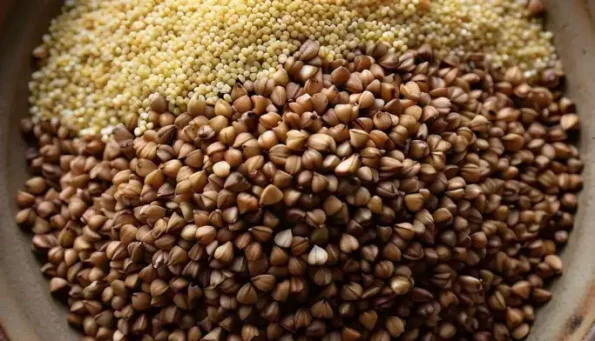
- Origin: Buckwheat millet originated in Asia and Eastern Europe.
- Nutrient Contents: Buckwheat Millet (Kuttu) features triangular seeds with a nutty flavour. Its impressive nutritional profile highlights high protein (13.7g), fibre (10.3g), and calcium (100mg) content. Buckwheat millet is commonly used in pancakes and soba noodles, supporting heart health, reducing cholesterol, and aiding weight management.
| Proso Millet (Chena / Barri) | Nutrients value as per 100 grams |
| Energy | 343 kcal |
| Protein | 13.7g |
| Fat | 3.4g |
| Carbohydrates | 63.9g |
| Fiber | 10.3g |
| Iron | 8.5mg |
| Calcium | 100mg |
| Potassium | 558mg |
- Health Benefits of Buckwheat Millet (Kuttu): Buckwheat millet is high in protein (13.7g/100g), fibre (10.3g/100g), and potassium (558mg/100g), supporting heart health and digestive health. Its vitamin B6 and folate content promote energy metabolism and red blood cell production. Buckwheat millet’s antioxidant properties also help prevent chronic diseases.
10. Kodo Millet

- Origin: Kodo millet is a native to India and Southeast Asia.
- Nutrient Contents: Kodo Millet features tiny, flat seeds with a mild flavour. Its nutritional benefits encompass high protein (8.3g), fibre (9g), and iron (1.7mg) content. Kodo millet is traditionally used in porridge, roti, and bread, supporting digestive health, reducing cholesterol, and aiding weight management.
| Proso Millet (Chena / Barri) | Nutrients value as per 100 grams |
| Energy | 309 kcal |
| Protein | 8.3g |
| Fat | 1.4g |
| Carbohydrates | 65.9g |
| Fiber | 9g |
| Iron | 1.7mg |
| Calcium | 35mg |
| Potassium | 188mg |
- Health Benefits of Kodo Millet: Kodo millet is rich in fibre (9g/100g) and antioxidants, supporting digestive health and preventing chronic diseases. Its iron (1.7mg/100g) and calcium (35mg/100g) content promote healthy red blood cells and strong bones. Kodo millet’s low-calorie content (309 kcal/100g) also aids weight management.
Benefits of Millets
1. Nutritional Benefits of Millets
- High protein content (average 10-12g per 100g) supports muscle growth and repair
- Rich in fibre (average 5-12g per 100g), supports digestive health and promotes satiety
- It is a good source of essential minerals like iron, calcium, potassium, and magnesium
- Rich in antioxidants and phytochemicals, protecting against chronic diseases
2. Health Benefits of Millets
- Supports heart health by reducing cholesterol levels and blood pressure
- Helps manage blood sugar levels and prevent diabetes
- Aids weight management due to low calorie and high fibre content
- Promotes digestive health and prevents constipation
- Boosts immune system due to high antioxidant content
- It may help reduce inflammation and improve symptoms of arthritis
- Supports bone health due to high calcium content
- It may help minimise the risk of certain cancers (e.g., colon, breast)
- Supports healthy gut bacteria and promotes prebiotic effects
- It may help improve cognitive function and memory
3. Therapeutic Benefits of Millets
- Gluten-free, suitable for celiac patients and those with gluten intolerance
- It may help manage symptoms of irritable bowel syndrome (IBS)
- Supports healthy blood lipid profiles
- It may help reduce the severity of menopausal symptoms
- Promotes healthy skin and hair
4. Preventive Benefits of Millets
- It may help prevent chronic diseases like heart disease, diabetes, and certain cancers
- It supports healthy ageing and reduces the risk of age-related diseases
- It may help prevent osteoporosis and fractures
- It supports healthy immune function and reduces the risk of infections
- It may help prevent cognitive decline and neurodegenerative diseases
Conclusion
Millets are:
- A vital component of a healthy and sustainable food system.
- Offering numerous benefits for human nutrition.
- Environmental sustainability.
- Economic development.
With their exceptional nutritional profile, climate resilience, and versatility, millets have the potential to address pressing global challenges such as hunger, malnutrition, and climate change. By promoting millet cultivation, consumption, and research, we can improve public health, support sustainable agriculture, enhance food security, and empower local communities, ultimately unlocking the full potential of these ancient grains to create a healthier, more sustainable future for all.
Frequently asked questions (FAQs)
What exactly are millets?
Millets are small-seeded grains from the Poaceae grass family, known for their high nutritional value and digestibility.
Can you name some common types of millets?
Common types include Sorghum (Jowar), Pearl (Bajra), Foxtail, Finger (Ragi), and Proso millets.
What makes millet beneficial for health?
Millets are nutrient-dense, rich in vitamins and minerals, and offer various health benefits, including aiding digestion and being suitable for gluten-intolerant individuals.
Are millets gluten-free?
Yes, millets are naturally gluten-free, making them an excellent choice for those with gluten intolerance.
How can I include millet in my diet?
Millets can be incorporated into your diet in porridge, stews, soups, and salads.
Can millet be a part of a weight management diet?
Due to their high fibre content and nutritional profile, millets can be an excellent addition to a weight management diet.
Is it hard to cook millet?
No, millet is relatively easy to cook, similar to cooking grains like rice or quinoa.
Does millet have any cardiovascular benefits?
Yes, millets contain nutrients like magnesium that support heart health.
Are there any specific millet that are good for heart health?
While all millet is generally good, varieties like Buckwheat and Amaranth are particularly noted for their cardiovascular benefits.
Why do health experts recommend millets?
Millets are recommended due to their rich nutritional content, including essential vitamins, minerals, and fibre.
Is millet suitable for everyone to eat?
Millets are generally suitable for most people, but individuals with specific health conditions should consult a healthcare provider before making significant dietary changes.
What are some easy ways to include millet in my diet?
Millets can be included in your diet as porridge, added to stews and soups, or used as a substitute for rice or quinoa in salads.
How do millets support digestive health?
Millets are rich in dietary fibre, which helps regulate bowel movements and improve overall gut health.
What are the health benefits of consuming millet?
Millets offer numerous benefits, such as aiding digestion, supporting heart health, being suitable for gluten intolerance, improving mood, and assisting in weight management.

